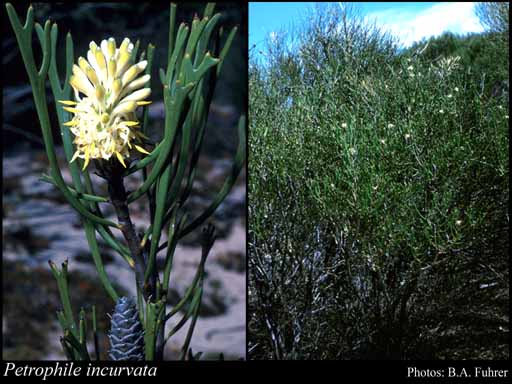- Reference
- J.Bot. 50:22 (1912)
- Conservation Code
- Not threatened
- Naturalised Status
- Native to Western Australia
- Name Status
- Current
Much-branched, bushy shrub, (0.3-)0.6-1.6 m high. Fl. yellow-cream-white, Aug to Oct. Yellow/white sand, gravelly sandy soils.

Scientific Description
Shrubs, 0.5-1 m high; branchlets glabrous. Leaves alternate, 70-120 mm long, glabrous; lamina flat, once divided or twice or more divided, pinnately divided, divided to the midrib, with (2-)3-4(-5) points or lobes; distance from base of leaf to lowest lobe 35-75 mm. Inflorescences not viscid, white or yellow. Perianth 10-14 mm long, hairy, the limb apex hairy all over; pistil 15-20 mm long; pollen presenter fusiform, hairy, 4-5 mm long. Cone with persistent scales, 20-30 mm long. Flowers in August, September or October. Occurs in the Eremaean (ER) or South-west (SW) Botanical Province(s), in the Yalgoo (YAL), Coolgardie (COO), Geraldton Sandplains (GS) or Avon Wheatbelt (AW) IBRA subregion(s).
Distribution
- IBRA Regions
- Avon Wheatbelt, Coolgardie, Geraldton Sandplains, Yalgoo.
- IBRA Subregions
- Katanning, Lesueur Sandplain, Merredin, Southern Cross, Tallering.
- Local Government Areas (LGAs)
- Coorow, Dalwallinu, Koorda, Moora, Mount Marshall, Mukinbudin, Perenjori, Wongan-Ballidu, Yalgoo.